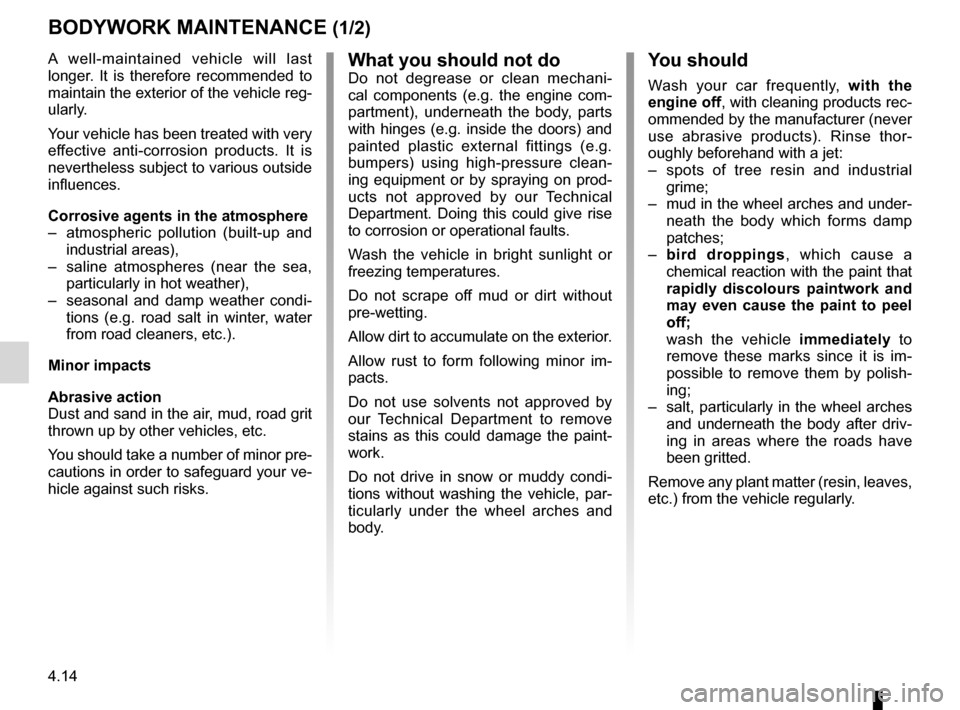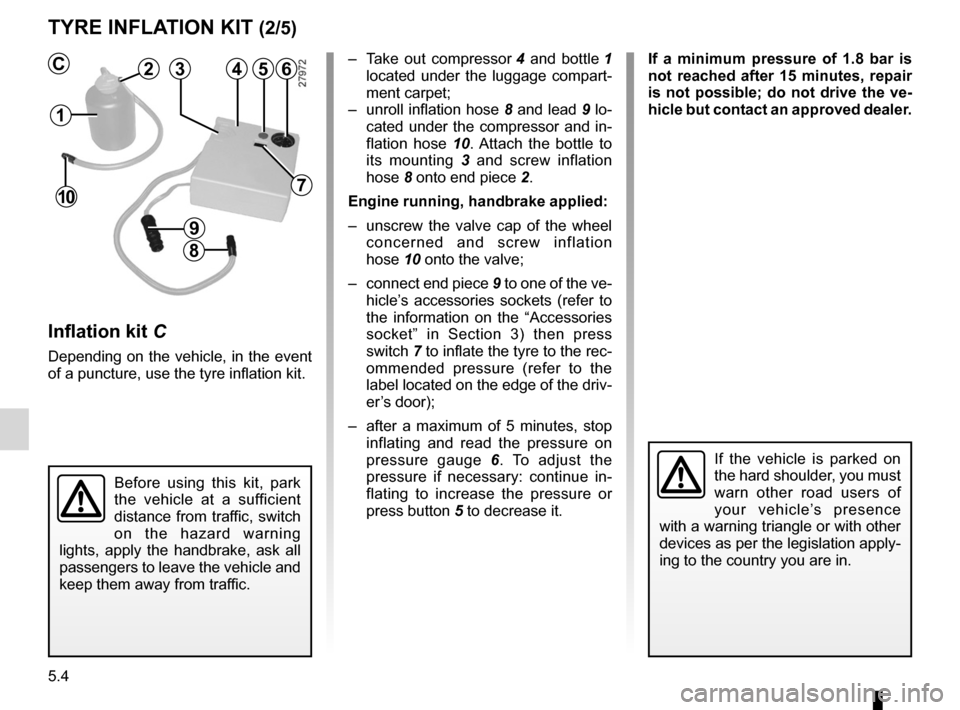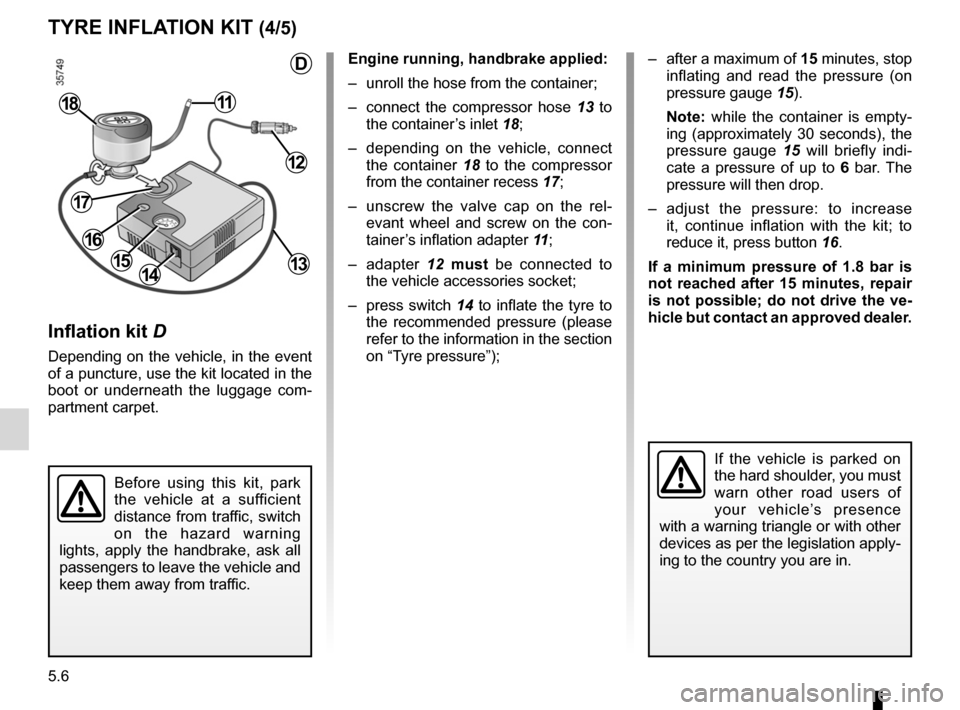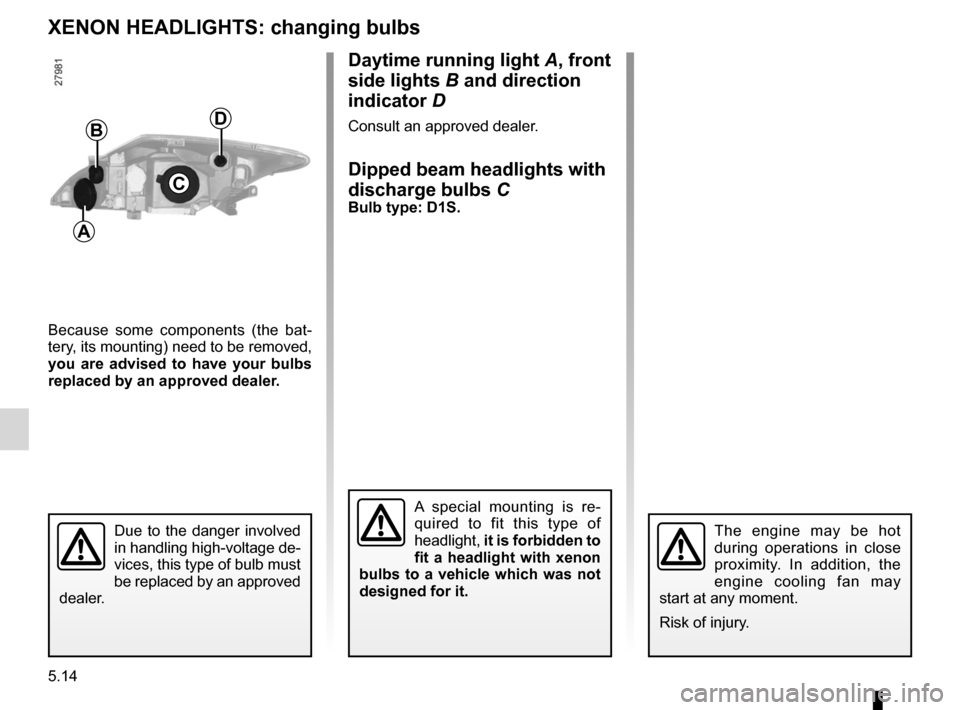2012 RENAULT LAGUNA COUPE engine
[x] Cancel search: enginePage 158 of 221

maintenance:bodywork ........................................ (up to the end of the DU)
washing ................................................ (up to the end of the DU)
paintwork maintenance ................................... (up to the end of the DU)
anti-corrosion protection ........................................ (current page)
4.14
ENG_UD26811_2
Entretien de la carrosserie (peinture mate) (X44 - X77 - J77 - X85 - B90 - X61 - TEST - X77 ph2 - X95 - B95 - D95 - K95 - J95 - R95 - L90 Ph2 - F90 Ph2 - R90 Ph2 - X62
ENG_NU_939-3_D91_Renault_4
Jaune NoirNoir texte
Bodywork maintenance
BODyWORk MAIntenAnCe (1/2)
you should
Wash your car frequently, with the
engine off, with cleaning products rec-
ommended by the manufacturer (never
use abrasive products). Rinse thor -
oughly beforehand with a jet:
– spots of tree resin and industrial
grime;
– mud in the wheel arches and under -
neath the body which forms damp
patches;
– bird droppings , which cause a
chemical reaction with the paint that
rapidly discolours paintwork and
may even cause the paint to peel
off;
wash the vehicle immediately to
remove these marks since it is im -
possible to remove them by polish -
ing;
– salt, particularly in the wheel arches
and underneath the body after driv -
ing in areas where the roads have
been gritted.
Remove any plant matter (resin, leaves,
etc.) from the vehicle regularly.
What you should not doDo not degrease or clean mechani -
cal components (e.g. the engine com -
partment), underneath the body, parts
with hinges (e.g. inside the doors) and
painted plastic external fittings (e.g.
bumpers) using high-pressure clean -
ing equipment or by spraying on prod-
ucts not approved by our Technical
Department. Doing this could give rise
to corrosion or operational faults.
Wash the vehicle in bright sunlight or
freezing temperatures.
Do not scrape off mud or dirt without
pre-wetting.
Allow dirt to accumulate on the exterior.
Allow rust to form following minor im -
pacts.
Do not use solvents not approved by
our Technical Department to remove
stains as this could damage the paint-
work.
Do not drive in snow or muddy condi -
tions without washing the vehicle, par-
ticularly under the wheel arches and
body.
A well-maintained vehicle will last
longer. It is therefore recommended to
maintain the exterior of the vehicle reg-
ularly.
Your vehicle has been treated with very
effective anti-corrosion products. It is
nevertheless subject to various outside
influences.
Corrosive agents in the atmosphere
–
atmospheric pollution (built-up and
industrial areas),
– saline atmospheres (near the sea,
particularly in hot weather),
– seasonal and damp weather condi -
tions (e.g. road salt in winter, water
from road cleaners, etc.).
Minor impacts
Abrasive action
Dust and sand in the air, mud, road grit
thrown up by other vehicles, etc.
You should take a number of minor pre-
cautions in order to safeguard your ve-
hicle against such risks.
Page 166 of 221

5.4
ENG_UD29151_1
Kit de gonflage des pneumatiques (X91 - B91 - K91 - D91 - Renault)
ENG_NU_939-3_D91_Renault_5
Jaune NoirNoir texte
tYre InFLA tIOn KIt (2/5)
Inflation kit C
Depending on the vehicle, in the event
of a puncture, use the tyre inflation kit.
– Take out compressor 4 and bottle 1
located under the luggage compart-
ment carpet;
– unroll inflation hose 8 and lead 9 lo-
cated under the compressor and in-
flation hose 10 . Attach the bottle to
its mounting 3 and screw inflation
hose 8 onto end piece 2.
engine running, handbrake applied:
– unscrew the valve cap of the wheel
concerned and screw inflation
hose 10 onto the valve;
– connect end piece 9 to one of the ve-
hicle’s accessories sockets (refer to
the information on the “Accessories
socket” in Section 3) then press
switch 7 to inflate the tyre to the rec-
ommended pressure (refer to the
label located on the edge of the driv-
er’s door);
– after a maximum of 5 minutes, stop
inflating and read the pressure on
pressure gauge 6 . To adjust the
pressure if necessary: continue in -
flating to increase the pressure or
press button 5 to decrease it. If a minimum pressure of 1.8 bar is
not reached after 15 minutes, repair
is not possible; do not drive the ve-
hicle but contact an approved dealer.
Before using this kit, park
the vehicle at a sufficient
distance from traffic, switch
on the hazard warning
lights, apply the handbrake, ask all
passengers to leave the vehicle and
keep them away from traffic.
1
23456
7
8
9
10
If the vehicle is parked on
the hard shoulder, you must
warn other road users of
your vehicle’s presence
with a warning triangle or with other
devices as per the legislation apply-
ing to the country you are in.
c
Page 168 of 221

5.6
ENG_UD29151_1
Kit de gonflage des pneumatiques (X91 - B91 - K91 - D91 - Renault)
ENG_NU_939-3_D91_Renault_5
Jaune NoirNoir texte
tYre InFLA tIOn KIt (4/5)
Inflation kit D
Depending on the vehicle, in the event
of a puncture, use the kit located in the
boot or underneath the luggage com -
partment carpet.
engine running, handbrake applied:
– unroll the hose from the container;
– connect the compressor hose 13 to
the container’s inlet 18;
– depending on the vehicle, connect
the container 18 to the compressor
from the container recess 17;
– unscrew the valve cap on the rel -
evant wheel and screw on the con -
tainer’s inflation adapter 11;
– adapter 12 must be connected to
the vehicle accessories socket;
– press switch 14 to inflate the tyre to
the recommended pressure (please
refer to the information in the section
on “Tyre pressure”);
1415
11
Before using this kit, park
the vehicle at a sufficient
distance from traffic, switch
on the hazard warning
lights, apply the handbrake, ask all
passengers to leave the vehicle and
keep them away from traffic.
18
If the vehicle is parked on
the hard shoulder, you must
warn other road users of
your vehicle’s presence
with a warning triangle or with other
devices as per the legislation apply-
ing to the country you are in.
– after a maximum of 15 minutes, stop
inflating and read the pressure (on
pressure gauge 15).
n ote: while the container is empty -
ing (approximately 30 seconds), the
pressure gauge 15 will briefly indi -
cate a pressure of up to 6 bar. The
pressure will then drop.
– adjust the pressure: to increase
it, continue inflation with the kit; to
reduce it, press button 16.
If a minimum pressure of 1.8 bar is
not reached after 15 minutes, repair
is not possible; do not drive the ve-
hicle but contact an approved dealer.
12
13
17
16
D
Page 176 of 221

bulbschanging ......................................... (up to the end of the DU)
lights: dipped beam headlights .................. (up to the end of the DU)
changing a bulb .................................... (up to the end of the DU)
lights: direction indicators .......................... (up to the end of the DU)
lights: side lights ........................................ (up to the end of the DU)
bulbs changing ......................................... (up to the end of the DU)
lights front ................................................. (up to the end of the DU)
5.14
ENG_UD25508_1
Projecteurs lampes au xénon : remplacement des lampes (X91 - D91 - R\
enault)
ENG_NU_939-3_D91_Renault_5
XenOn HeADLIGHtS: changing bulbs
Because some components (the bat -
tery, its mounting) need to be removed,
you are advised to have your bulbs
replaced by an approved dealer.
A special mounting is re -
quired to fit this type of
headlight, it is forbidden to
fit a headlight with xenon
bulbs to a vehicle which was not
designed for it.
Due to the danger involved
in handling high-voltage de-
vices, this type of bulb must
be replaced by an approved
dealer.The engine may be hot
during operations in close
proximity. In addition, the
engine cooling fan may
start at any moment.
Risk of injury.
B
A
c
D
Daytime running light A, front
side lights B and direction
indicator D
Consult an approved dealer.
Dipped beam headlights with
discharge bulbs C
Bulb type: D1S.
Page 182 of 221

5.20
ENG_UD22226_3
Fusibles (X91 - D91 - Renault)
ENG_NU_939-3_D91_Renault_5
FuSeS (2/2)
Some accessories are protected by
fuses located in the engine compart -
ment in fuse box A.
However, because of their reduced ac-
cessibility, we advise you to have your
fuses replaced by an approved Dealer.
A
Allocation of fuses (DePenDInG On tHe eQuIPMent LeVeL)
Symbol Allocation SymbolAllocation
ZInterior lightingRadio amplifier
Interior rear-view mirrorîRadio
CHeated rear screenaInstrument panel
ÌHornnDriving correction devices
Child safetyElectric seats
DIndicatorëAccessories sockets
Electric windowsyVentilation
ñHeated seatstAir conditioning
ERear screen wiperÆCigar lighter
[SunroofHeating system
Electronic parking brakeHWindscreen washer
ÝTowing equipment supply
Page 183 of 221

batterytroubleshooting ............................... (up to the end of the DU)
5.21
ENG_UD29103_2
Batterie : dépannage (X91 - D91 - Renault)
ENG_NU_939-3_D91_Renault_5
connecting a battery charger
t he battery charger must be com -
patible with a battery with nominal
voltage of 12 volts.
Follow the instructions given by the
manufacturer of the battery charger
you are using.
t o avoid all risk of sparks:
Do not place metal objects on the bat-
tery as this could create a short circuit
between the terminals.
Battery
Never disconnect it.
Battery
BA tter Y: breakdown recovery (1/2)
Handle the battery with care
as it contains sulphuric acid,
which must not come into
contact with eyes or skin. If
it does, wash the affected area with
plenty of cold water.
Ensure that naked flames, red hot
objects and sparks do not come into
contact with the battery as there is a
risk of explosion.
The engine may be hot when car -
rying out operations in close prox -
imity. In addition, the engine cooling
fan can come on at any moment.
Risk of injury.
Starting the vehicle using the
battery from another vehicle
If you have to use the battery from an-
other vehicle to start, obtain suitable
jump leads (with a large cross section)
from an approved dealer or, if you al -
ready have jump leads, ensure that
they are in perfect condition.
the two batteries must have an iden-
tical nominal voltage of 12 volts. The
battery supplying the current should
have a capacity (amp-hours, Ah) which
is at least the same as that of the dis-
charged battery.
Special procedures may be
required to charge some
batteries. Contact an ap -
proved Dealer.
Avoid all risk of sparks which may
cause an immediate explosion, and
charge the battery in a well-venti -
lated area.
Risk of serious injury.
Deactivate the Stop and
Start function for any opera -
tion performed in the engine
compartment.
Page 184 of 221

5.22
ENG_UD29103_2
Batterie : dépannage (X91 - D91 - Renault)
ENG_NU_939-3_D91_Renault_5
Battery in the engine compartment
Connect the positive cable A to the
support 1 on the (+) terminal, then to
the (+) terminal 2 of the battery sup -
plying the current.
Connect the negative cable B to the (–)
terminal 3 of the battery supplying the
current and then to the (–) terminal 4 of
the discharged battery.
BA tter Y: breakdown recovery (2/2)
Battery in the luggage compartment
(V6 engines)
Use the terminals in the engine com -
partment.
Turn screw 6 one quarter of a turn to
the right, then pull cover 7 upwards to
access the 8 (+) terminal. Connect the
positive cable A to the support 8 on
the (+) terminal, then to the (+) termi-
nal 3 of the battery supplying the cur -
rent.
Connect the negative cable B to the (–)
terminal 4 of the battery supplying the
current and then to the (–) terminal 5.
Starting the vehicle using the
battery from another vehicle
(continued)
Ensure that there is no risk of contact
between the two vehicles (risk of short
circuiting when the positive terminals
are connected) and that the discharged
battery is properly connected. Switch
off your vehicle ignition.
Start the engine of the vehicle supply -
ing the current and run it at an interme-
diate engine speed.
8
5
6
7
Start the engine, and as soon as it starts running, disconnect cables A and B in
reverse order (4 - 3 - 2 - 1 or 5 - 3 - 2 - 8).
Check that there is no con-
tact between leads A and B
and that the positive lead A
is not touching any metal
parts on the vehicle supplying the
current.
Risk of injury or damage to the ve-
hicle.
Leads A and B must only be con-
nected to the terminals indicated.
1
A
B
1
4
23
Page 187 of 221

wiper blades ......................................... (up to the end of the DU)
wipers blades ............................................. (up to the end of the DU)
5.25
ENG_UD4848_1
Balais d’essuie-vitres (X91 - D91 - Renault)
ENG_NU_939-3_D91_Renault_5
Wipers (replacing blades)
WInDScreen WIPer BLADeS
replacing windscreen wiper
blades 1
With the ignition on and engine
switched off, lower the windscreen
wiper stalk completely: they stop
slightly away from the bonnet.
Lift wiper arm 3 , pull tab 2 (move -
ment A) and push the blade upwards.
t o refit
Slide the blade along the arm until it
clips on. Make sure that the blade is
correctly locked in position. Return the
windscreen wiper stalk to the park po-
sition.– In frosty weather, make
sure that the wiper blades
are not stuck by ice (to
avoid the risk of the motor
overheating).
– Check the condition of the wiper
blades.
Replace the wiper blades as soon
as they begin to lose efficiency
(approximately once a year).
Whilst changing the blade, take care
not to drop the arm onto the window
after it has been removed as this
may break the window.
1
2
3
Check the condition of the wiper
blades. You are responsible for their
service life:
– clean the blades and the wind -
screen regularly with soapy
water;
– do not use them when the wind -
screen is dry;
– free them from the windscreen
when they have not been used
for a long time.
A